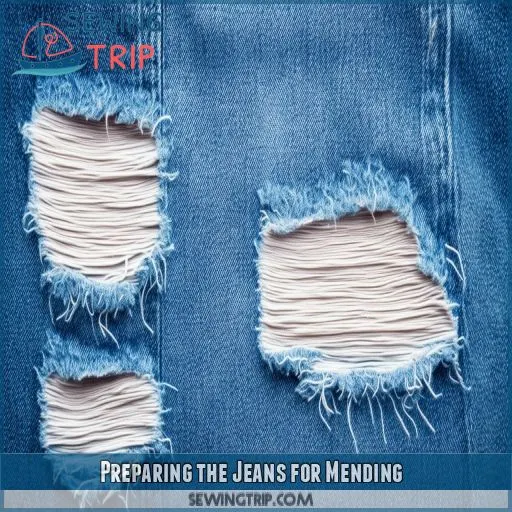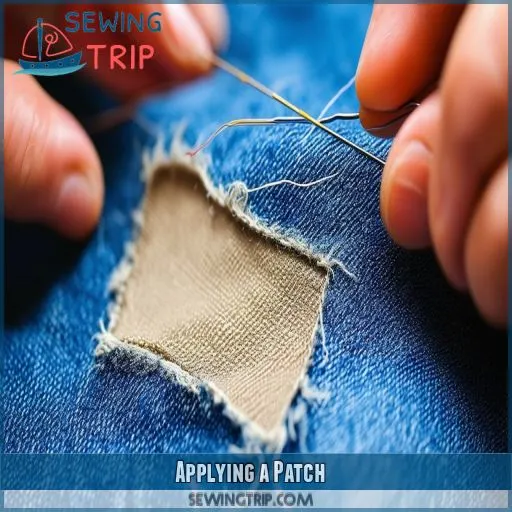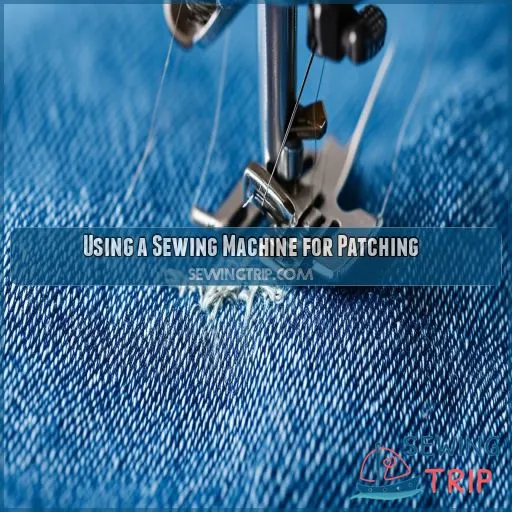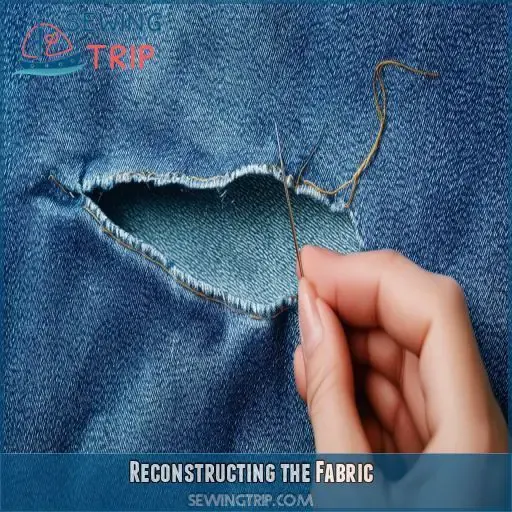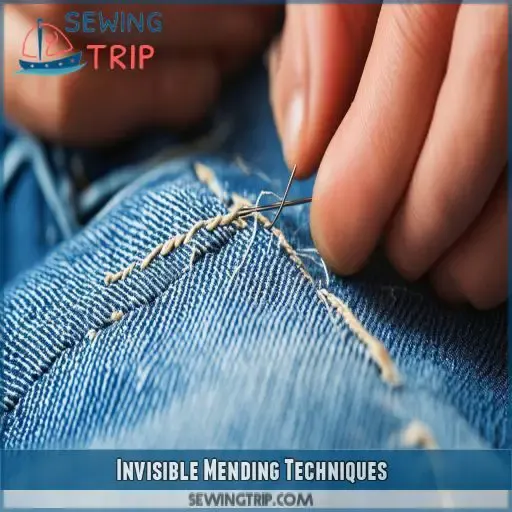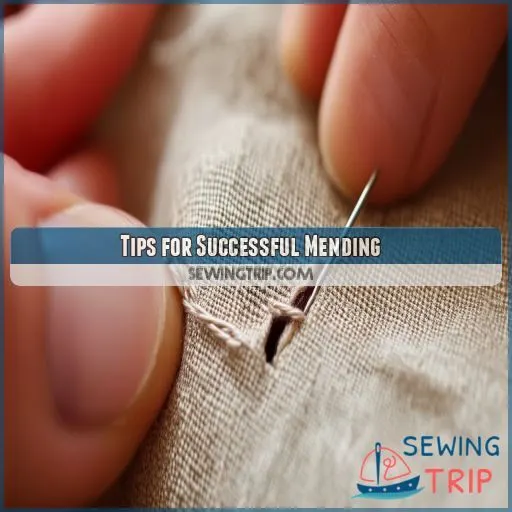This site is supported by our readers. We may earn a commission, at no cost to you, if you purchase through links.

With step-by-step details on repairing small holes with hand-sewing and patching larger tears, this guide will teach you the perfect techniques.
Mastering the art of mending puts one in control of one’s wardrobe, liberating one from costly replacements.
Now, let’s dive into the world of denim repair
Table Of Contents
- Key Takeaways
- How to Sew a Hole in Jeans?
- Preparing the Jeans for Mending
- Hand Sewing a Small Hole
- Applying a Patch
- Using a Sewing Machine for Patching
- Darning With a Sewing Machine
- Reinforcing the Repair
- Reconstructing the Fabric
- Invisible Mending Techniques
- Tips for Successful Mending
- Bonus Ideas: Get Creative
- Frequently Asked Questions (FAQs)
- Conclusion
Key Takeaways
- Don’t let a small hole turn into a big headache – a stitch in time really does save nine! With these techniques, you’ll be mending like a pro in no time.
- From trimming frayed edges to choosing the right thread, it’s all in the details. Remember, Rome wasn’t built in a day, and neither is the perfect jean repair.
- Get creative with your mends! Who says patching has to be boring? Turn that tear into a conversation piece with some funky embroidery or a cool appliqué.
- Practice makes perfect, so start small and work your way up. Before you know it, you’ll be the Michelangelo of mending, turning those holey jeans into holy grails!
How to Sew a Hole in Jeans?
To sew a hole in jeans, start by trimming any frayed edges around the tear. Choose a thread color that matches your denim and a sturdy needle suitable for thick fabric.
For small holes, weave stitches vertically across the gap, tying off securely inside. Larger holes may require a patch: cut a piece slightly bigger than the hole, position it, and sew zigzag stitches around the edges.
If you’re using a sewing machine, opt for a denim needle and sew about 0.5 inches from the hole’s edge for strength. Don’t forget to reinforce your repair from the inside.
With these techniques, you’ll be well on your way to mastering jean mending
Preparing the Jeans for Mending
First, cut out the frayed edges around a hole to clean the borders. Secondly, measure the size of the hole or tear and choose a thread color that will match your jeans fabric. Also, select a sturdy needle suitable for denim.
Trim Frayed Edges With Sharp Fabric Scissors
Break out the good fabric scissors and trim those frayed edges. Cutting clean borders around the hole ensures a smooth repair. Carefully snip any loose threads or fabric trim. Precision here sets the base for practical sewing or patching on your denim.
Measure the Size of the Hole or Tear
To accurately measure the size of the hole or tear in your jeans, use a ruler or measuring tape, ensuring precision. Proper measurement allows you to choose appropriate patch materials and plan reinforcement options, preventing common repair mistakes and ensuring a seamless fix
Select Thread Color That Matches the Jeans Fabric
To achieve a seamless repair, select thread color that matches the jeans fabric.
- Hold different shades against the jeans under natural light.
- Choose embroidery or silk thread for strength and flexibility.
- Prioritize invisible stitching for discreet patches.
- Double-check the matching fabric, thread, and needle
Choose a Sturdy Needle Suitable for Denim
For denim repairs, choose a heavy-duty needle in either 90/14 or 100/16—this would be appropriate for thick fabrics in general and darning. Ensure the needle is of good strength and sharp enough to go through your denim. Choose appropriate types and materials for the needle for effective, long-lasting repairs.
Hand Sewing a Small Hole
Using a matching thread, thread your need and sew vertical stitches across the hole to replace and restore. Tie off the safe inside the jeans, trimming off the remaining threads for a neater appearance.
Thread the Needle With Matching Thread
First, choose a denim-compatible needle size of 90/14 or 100/16. Then, match the thread type with the color of the jeans. Adjust even thread tension to ensure smooth stitching. Once your needle’s threaded, you can begin hand-sewing the rip in your pants.
Weave Stitches Vertically Across the Hole
Use the threaded needle to weave vertical stitches across the hole. Begin from the bottom edge and work upwards, ensuring stitches are close together. This method, known as a vertical blind stitch, helps create a strong, almost invisible seam
Tie Off the Thread Securely Inside the Jeans
To secure the thread inside the jeans, tie a tight knot with controlled thread tension:
- Pull the needle thread through to form a loop.
- Pass the needle through the loop.
- Tighten the knot close to the fabric.
- Repeat for extra knot strength.
- Trim the thread near the knot
Trim Any Excess Thread
Trim any excess thread with sharp fabric scissors for a neater finish. Cut close to, but not through, the knot. Using a lighter thread weight will thin out bulk while cutting precisely will be necessary for maintaining your stitch density and integrity throughout your work.
Applying a Patch
Cut a slightly larger size patch than the whole hole. Assemble it on top of the hole and hold it firmly to stick. Then, do zigzag stitches all around the patch’s edges for firm attachment.
Cut a Patch Slightly Larger Than the Hole
Cut a patch a little larger than the hole; it should sufficiently cover the damaged area. Use fabric of about the same weight as your jeans and as close to the color as can be. Remember to leave a seam allowance around the edges.
A good patch size helps with even stitching and for durability reasons. This step is essential in getting a seamless repair
Position the Patch Over the Hole and Press Firmly
Position the patch over the rip, ensuring perfect alignment. Apply an iron-on bonding web or glue to the edges. Press firmly with a hot iron to secure the placement. Hold in place for several seconds to create a strong bond. Make sure the patch lies flat and even on the fabric for a clean finish
Sew Zigzag Stitches Around the Patch Edges
Align the patch over the hole and press firmly. Sew zigzag stitches around the patch edges for strong adhesion. Follow these steps:
- Check thread tension and stitch density.
- Stitch the patch in place, maintaining even spacing.
- Finish the edges of the patch with Fray Check.
- Add decorative touches like sashiko for flair
Using a Sewing Machine for Patching
To sew the patch in place with your sewing machine, use a denim or heavy-duty needle for best results. Make sure to sew 0.5 inches from the edge of the hole for added strength and durability
Sew the Patch in Place With a Sewing Machine
If you want to attach the patch using a sewing machine, place your patch material over the hole. Of course, it should be large enough to conceal the tear.
Then, using either a zigzag or straight stitch on your machine, start sewing by first preparing your fabric, then beginning small and working over the area as a whole with even pressure
Use a Denim or Heavy-duty Needle
Use a denim or heavy-duty needle for the thickness of the fabric used in jeans and the required strength of the thread. This choice will provide you with smooth stitching without breaking.
For invisible repair, match your needle size to the weight of the denim.
From here, using a shorter stitch length should clean up the rip effectively without skipped stitches and ensure durable mending, even for small holes
Sew 0.5 Inches From the Hole Edge for Strength
Place your patch 0.5 inches away from the edge of the hole. The distance provides you with essential support methods for your jeans.
Adjust the thread tension and use the correct type of needle, which is long for denim.
Ensure compatibility with the fabric by resizing your patch according to the hole.
You’ll master this repair to give your favorite jeans a new life
Darning With a Sewing Machine
To darn with a sewing machine, attach a darning foot for better control and visibility, and lower the feed dogs to allow manual fabric movement. Select a straight stitch and adjust the stitch length, ensuring you’re ready to reconstruct the fabric with precision and care
Use a Darning Foot for Better Control and Visibility
Now that you’ve positioned your patch, it’s time to level up your sewing game. Swap out your regular presser foot for a darning foot. This nifty tool gives you better control and improves thread visibility as you mend. It’s like having a magnifying glass for your needle! With this attachment, you’ll navigate those tricky repairs like a pro
Lower the Feed Dogs for Manual Fabric Movement
Now that you have attached the darning foot lower your feed dogs. This step will enhance the control of the machine and manipulation of the fabric. Here’s how to do it:
- Locate the feed dog lever or switch
- Move it to the "down" position
- Testing by turning the handwheel
- Keep feed dogs lowered
This setup provides you with entire manual movement, which enables exact repairs.
Choose a Straight Stitch and Adjust the Stitch Length
Select a straight stitch on your machine and adjust the stitch length. With the darning foot attached, you’ll have better control over fabric movement. Experiment with different lengths to match your jeans’ twill weave:
| Stitch Length | Effect | Best For |
|---|---|---|
| Short (1-2mm) | Dense | Small holes |
| Medium (2-3mm) | Balanced | General repairs |
| Long (3-4mm) | Loose | Large tears |
Reinforcing the Repair
To reinforce your jean repair, apply fusible interfacing to the inside of the jeans, cutting it slightly larger than the hole. When ironing the interfacing in place, be careful not to pinch the hole together, ensuring a flat and smooth reinforcement
Apply Fusible Interfacing to the Inside of the Jeans
Now that you’ve mastered darning, let’s reinforce your repair with fusible interfacing. This miracle material adds strength and durability to your mend. Choose a lightweight denim interfacing for best results. Place it on the inside of your jeans, covering the darned area. Set your iron to high heat, no steam, and press firmly to fuse it in place
Cut the Interfacing Slightly Larger Than the Hole
Now that you have applied fusible interfacing, it must be correctly sized.
Cut the interfacing about 1/4 inch larger than the hole on all sides. The side allowance of 1/4 inch ensures that you get full coverage and stronger reinforcement.
The right size is essential to effect a seamless repair. You’re in control here—precision is vital to mastering this technique
Avoid Pinching the Hole Together While Ironing
Resist the urge to squeeze the hole shut. Instead, lay the fabric flat and smooth.
Apply heat at a medium-high setting without steam so that interfacing fuses won’t distort the jeans’ shape.
You need to remind yourself again that you’re reinforcing this area of denim fabric—not yet closing the hole.
Your patience here will pay off in the final repair
Reconstructing the Fabric
To reconstruct the fabric, start by following the warp threads and stitching up and down across the hole. Then, sew diagonally to mimic the jeans’ twill weave, creating a sturdy and natural-looking repair that blends with the original fabric texture
Follow the Warp Threads and Stitch Up and Down
Now that you’ve prepared your jeans, it’s time to reconstruct the fabric. Follow the warp thread direction for a seamless repair. You’ll need to:
- Adjust your stitch length to match the fabric’s weave
- Control fabric movement carefully as you sew
- Use a darning foot for better visibility
- Lower the feed dogs for manual control
Start stitching up and down, following the vertical warp threads. This technique mimics the original fabric structure, making your repair less noticeable. Remember, patience is key here. Take your time and maintain steady control over your fabric. With practice, you’ll master this skill and breathe new life into your favorite jeans
Sew Diagonally to Mimic the Jeans’ Twill Weave
Now, when you have sewn up and down, emulate that most characteristic feature of denim: the twill weave, by changing your thread tension and sewing in a diagonal direction. This will ensure that you’re heavily reinforcing the fabric yet creating little visual disturbance of the original texture.
Use a sharp needle of a type appropriate for the weight of your denim, and feel free to play with stitch length to get the perfect balance. Remember, seam allowance here counts—leave enough so it doesn’t fray.
As you sew, you’ll feel like a kind of denim detective, working out the secrets of the fabric. Keep your stitches even, and watch how your repair transforms from a visible patch to an invisible mend.
You’re becoming a master at jean resurrections!
Invisible Mending Techniques
To achieve an invisible mend on your jeans, choose thread that perfectly matches the denim color and use small, discreet stitches that blend seamlessly with the fabric’s weave. For larger holes, select a patch fabric that closely resembles your jeans’ color and texture, and consider decorative techniques like sashiko-inspired stitching to add a stylish touch to your repair
Use Matching Thread Color for Discretion
For invisible mending, choose a thread color as close to the color of your jeans as possible. Consider where the hole is and what kind of mend aesthetic you choose. Lovely, good-quality thread is called for to create a substantial repair.
Here’s how you can nail down patch selection:
- Compare thread with jeans under natural light
- Test on a hidden area first
- If in doubt, sew with a slightly darker thread
Sew Small, Inconspicuous Stitches
Now that you have matched your thread color focus on small and inconspicuous stitches. Use a fine needle and adjust the density of your stitches. Whether sewing by hand or machine, keep your stitches close together and tight. This will let your repair seamlessly blend into the rest of the fabric.
Find a Similar Fabric for Patches
When patching jeans, finding a similar fabric is key. You’ll want to match the denim’s texture and color closely. Consider patch placement carefully, as it’ll affect the repair’s visibility. If you’re feeling adventurous, experiment with contrasting colors or custom designs for a unique look
Decorative Options Like Sashiko-inspired Stitching
After finding matching fabric, consider adding flair with sashiko-inspired stitching. Try various stitch patterns and thread colors to create eye-catching embellishments. Experiment with custom patch shapes and decorative mending techniques. You’ll turn your repair into a unique fashion statement while mastering the art of visible mending
Tips for Successful Mending
When mending holes in your jeans, start with smaller repairs to build your confidence and skills. As you gain experience, you’ll be ready to tackle larger holes, and remember to take your time and enjoy the process of giving your favorite jeans new life
Start With Small Holes and Work Your Way Up
When you’re new to mending jeans, start with small holes to build your confidence. These beginner-friendly techniques will help you master the basics before tackling larger repairs.
Begin with a tiny tear, practicing your stitches and getting comfortable with the process. As you overcome obstacles and gain skills, gradually work up to bigger challenges.
You’ll find mending becomes a satisfying hobby, offering a sense of accomplishment with each successful repair. Remember, every expert started as a novice, so don’t be discouraged if your first attempts aren’t perfect.
With patience and practice, you’ll soon be fixing holes like a pro
Take Your Time and Enjoy the Process
Knowing how to do minor repairs will make a more giant hole not seem quite so overwhelming after you’ve gained some confidence. There’s no rush here. Take your time to choose matching thread and even work in some decorative stitches should you want that special touch.
Invisible patches are suitable for beginners. They’re inconspicuous yet solid.
As you sew, focus on every stitch, feeling how you’re giving new life to your favorite jeans. Don’t be afraid to experiment with different techniques.
As you practice, your style will evolve, and you’ll become a master at mending—one who can repair effortlessly. Enjoy the journey and watch your skill grow with every repair
Bonus Ideas: Get Creative
Get creative with your jeans repair by using contrasting thread colors for a unique look or incorporating embroidery and appliqué for decorative mends. You can also experiment with different patch shapes and sizes to turn your repair into a stylish feature, making your jeans truly one-of-a-kind
Use Contrasting Thread Colors for a Unique Look
Want to make your jean repairs stand out? Try using contrasting thread colors for a unique look. Here’s how:
- Choose a bold, complementary color
- Use thicker embroidery floss for visibility
- Experiment with different stitch patterns
- Combine multiple thread colors for a rainbow effect
You’ll turn those pesky holes into eye-catching features, giving your jeans a custom, artisanal vibe. It’s a fun way to express your style!
Incorporate Embroidery or Appliqué for Decorative Mends
Bring on the embroidery and appliqué to take your visible mending to a new level by turning those annoying holes into striking features.
Try embroidering brightly colored flowers and geometric shapes around the repair. Or, when that scene gets old, just cut some fun shapes out of fabric scraps and appliqué them over the hole.
You won’t only mend your jeans but also add a very unique touch to your garment that will set it apart
Experiment With Different Patch Shapes and Sizes
Don’t stop at embroidery – let your creativity soar with patch shapes and sizes! Try heart-shaped patches for a whimsical touch or geometric designs for a modern twist. Mix contrasting patches to create a patchwork effect. Experiment with oversized patches that become a statement piece. Remember, creative mending isn’t just about fixing holes – it’s about expressing your unique style
Frequently Asked Questions (FAQs)
How do you sew a hole in jeans?
You’ll need fabric scissors, thread, and a needle. Trim frayed edges, then weave vertical stitches across the hole. Tie off inside the jeans. For larger holes, apply a patch using zigzag stitches around the edges
What is the best stitch for repairing jeans?
You’ll want to use a zigzag stitch for repairing jeans. It’s strong, flexible, and adapts well to denim’s weave. Set your machine to a medium width and length, ensuring you’re catching both sides of the tear securely
How to sew ripped pants by hand?
Threadbare jeans meet nimble fingers. You’ll need a needle, matching thread, and patience. Start by trimming frayed edges, then weave small stitches across the tear. Secure knots on the inside, and you’ve conquered the rip without breaking a sweat
Can you sew up ripped jeans?
Yes, you can sew up ripped jeans. Grab a needle, matching thread, and scissors. Trim frayed edges, then stitch across the tear using small, tight stitches. For larger holes, consider patching or darning techniques for added strength
Can you mend jeans without removing them?
Like a surgeon operating on a patient, you can mend jeans while wearing them. Use a needle and thread to carefully stitch the hole from the inside. It’s tricky but doable, giving you control over the repair process
How do you fix a hole in the crotch area?
To fix a crotch hole, turn jeans inside out and trim frayed edges. Apply a patch slightly larger than the hole. Pin it in place, then use a zigzag stitch to secure the patch, reinforcing the area for durability
Whats the best way to mend stretch denim?
To mend stretch denim, use a zigzag stitch to maintain flexibility. Choose a thread that matches the fabric color and a ballpoint needle. Apply interfacing to stabilize the area, then sew in the direction of the stretch for best results
Can you repair jeans with iron-on patches?
You can repair jeans with iron-on patches. They’re quick and easy to apply. Just cut the patch to size, position it over the hole, and press with a hot iron. For extra durability, stitch around the edges
How do you mend jeans without a visible patch?
You can mend jeans invisibly by darning or using a hidden patch. Use matching thread and small stitches to blend repairs. For larger holes, apply a patch inside the jeans and stitch it carefully. Practice on scrap fabric first
Conclusion
This may be hard to believe, but a single pair of jeans repair can save as much as 6,840 gallons of water. You’ll see that learning how to repair holes in jeans won’t only save you some bucks but will help toward your action on sustainability.
With the techniques covered herein, you can mend any type of denim wear. As usual, with everything else, it requires practice to make it perfect—start small and work your way up.
Get creative with your fixes. Your newly repaired jeans will attest to your skill and regard for the environment

